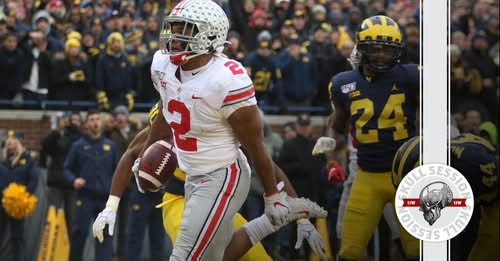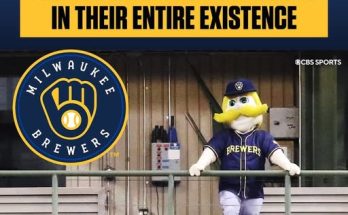J.K. Dobbins believes his name belongs on Ohio State’s Mount Rushmore of running backs, pointing to his status as the only Buckeye ever to eclipse 2,000 rushing yards in a single season.
J.K. Dobbins has never been one to shy away from confidence, and for good reason. His time at Ohio State was nothing short of spectacular, and when the conversation turns to the Mount Rushmore of Buckeye running backs—a pantheon reserved for the very best in program history—Dobbins believes he should be an “automatic yes.” His argument isn’t based on bravado alone; it’s backed by a record that speaks volumes, as he remains the only player in Ohio State’s storied history to rush for over 2,000 yards in a single season. For a program that has produced legendary backs like Archie Griffin, Eddie George, and Ezekiel Elliott, that feat is nothing short of remarkable.
When people talk about the greatest running backs to wear scarlet and gray, certain names immediately dominate the conversation. Archie Griffin, the only two-time Heisman Trophy winner in college football history, is an undeniable fixture. Eddie George, the 1995 Heisman winner, is another lock, with his power running and dominance in the Big Ten etched into Buckeye lore. Ezekiel Elliott, with his back-to-back 1,800-yard seasons and heroic playoff performances that delivered Ohio State a national title in 2014, is widely considered a modern legend. For Dobbins to claim he belongs alongside these names is bold, but the case he makes is compelling, and the statistics support it in a way that is hard to dispute.
Dobbins’ final season at Ohio State in 2019 was nothing short of historic. He carried the ball 301 times, piling up 2,003 yards and 21 rushing touchdowns, while adding another 247 receiving yards and two scores through the air. To understand the magnitude of that accomplishment, consider the context: Ohio State has long been a running back factory, churning out elite talent for decades. Yet, through all those years, through all the Hall of Famers and Heisman winners, no one had ever reached the 2,000-yard milestone until Dobbins did it. That alone cements his place in the conversation. But his legacy isn’t built on numbers alone; it’s also about how he played the game and the impact he had during his time in Columbus.
From the moment Dobbins arrived on campus in 2017, expectations were high. The Buckeyes had a crowded backfield, but the freshman from La Grange, Texas, wasted no time proving he was special. In his debut game against Indiana, Dobbins exploded for 181 yards, setting the tone for what would become one of the most productive freshman seasons in Ohio State history. He finished that year with 1,403 yards and seven touchdowns, breaking Maurice Clarett’s freshman rushing record. For most players, that would have been the pinnacle of their college career, but for Dobbins, it was just the beginning.
His sophomore season in 2018 was a bit of a rollercoaster, statistically speaking. Sharing carries with Mike Weber, Dobbins’ production dipped slightly to 1,053 yards and 10 touchdowns, still a solid year by any measure but below his own high standards. Critics wondered if his freshman breakout was an anomaly, but Dobbins used that season as fuel for what would come next. Determined to reassert himself as one of the nation’s best, he entered 2019 with a renewed focus and a chip on his shoulder. The results were breathtaking.
The 2019 Ohio State team was loaded with talent, featuring Justin Fields at quarterback and a dominant defense anchored by Chase Young. Yet, in an offense brimming with playmakers, Dobbins stood out as the heartbeat. Week after week, he shredded defenses with a combination of power, vision, and breakaway speed. He wasn’t just putting up yards; he was doing it against elite competition, in big games, when the Buckeyes needed him most. His performance against Michigan, in what would be his final regular-season game as a Buckeye, was the stuff of legend: 211 yards and four touchdowns on the ground, leading Ohio State to a resounding 56-27 victory over its archrival. That game alone secured his place in the hearts of Buckeye fans forever.
Then came the Big Ten Championship against Wisconsin, where Dobbins added another 172 yards and a touchdown, helping Ohio State rally from an early deficit to claim the conference crown. In the College Football Playoff semifinal against Clemson, he delivered yet again, rushing for 174 yards and catching six passes for 47 more, despite battling an ankle injury. Had a couple of breaks gone Ohio State’s way in that game, Dobbins might have had the chance to showcase his talent on the biggest stage of all: the national championship. Even without that opportunity, his body of work was undeniable.
When you step back and look at Dobbins’ career totals—4,459 rushing yards and 38 touchdowns over three seasons—it becomes clear why he feels so strongly about his place in Buckeye history. He ranks second all-time in career rushing yards at Ohio State, trailing only Archie Griffin, and he did it in just three seasons, without the benefit of a senior year to pad his stats. His yards-per-carry average of 6.2 is among the best in program history, and his durability was never in question, as he played in all but one game during his college career.
The debate over the Mount Rushmore of Ohio State running backs is, of course, subjective. There are more than four worthy candidates, which means some all-time greats will inevitably be left off. Archie Griffin, Eddie George, and Ezekiel Elliott are generally considered locks, which leaves one spot for players like Dobbins, Keith Byars, Howard “Hopalong” Cassady, and Chic Harley, among others. Each of those players left an indelible mark on the program, and making a definitive choice is almost impossible. But Dobbins’ argument rests on two pillars: his statistical dominance and his role in an era when the competition was as fierce as ever.
In today’s game, where running backs often split carries in pass-heavy offenses, reaching 2,000 rushing yards is a monumental achievement. It requires not only talent but also consistency, durability, and the ability to deliver in high-pressure situations. Dobbins checked every box. He wasn’t just a product of Ohio State’s system; he was the engine that made the offense go, particularly in 2019 when the Buckeyes leaned on him in critical moments. That combination of individual excellence and team success strengthens his case in a way that few can match.
Off the field, Dobbins was a leader and a competitor who embodied the values Ohio State holds dear. His journey to Columbus was marked by perseverance—overcoming injuries in high school, dealing with personal loss, and proving himself time and again on the biggest stages. Those experiences shaped him into a player who thrived under pressure, who embraced the spotlight rather than shying away from it. When you talk about the qualities that define a Buckeye legend, Dobbins checks every box.
After his college career, Dobbins transitioned to the NFL, where he was drafted by the Baltimore Ravens. While his professional journey has had its share of challenges, including injuries, his time at Ohio State remains a testament to his talent and determination. For fans who watched him dominate the Big Ten, there is no doubt that he belongs in the conversation for Ohio State’s Mount Rushmore of running backs. Whether he ultimately makes that mythical monument or not, his legacy is secure: he was one of the greatest to ever do it in Columbus, and the numbers prove it.
So when J.K. Dobbins says he should be an “automatic yes,” he isn’t speaking from arrogance—he’s speaking from accomplishment. In a program built on tradition, where excellence is the standard and legends are the norm, doing something no one else has ever done is the ultimate trump card. And until another Buckeye running back rushes for 2,000 yards in a season, Dobbins will hold that distinction alone, standing as a giant among giants in the rich history of Ohio State football.



